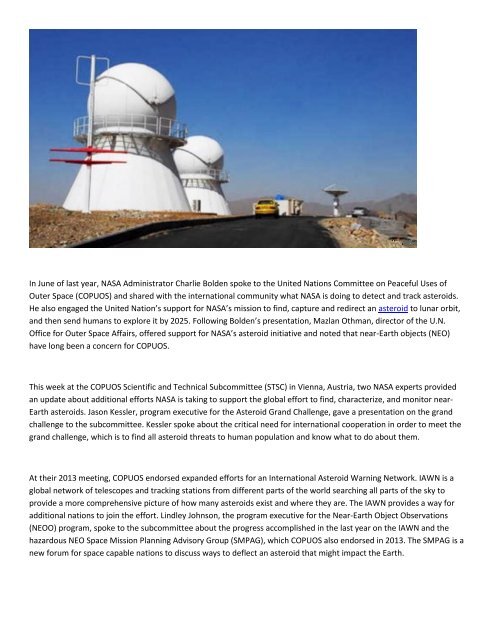Koyal Group InfoMag - NASA Experts Continue To Engage United Nations On Asteroid Initiative
NASA doubled the money spent in the search for potentially hazardous asteroids through the NEOO program in Fiscal Year 2014, and is committed to developing new ways to use existing data by seeking for innovative ideas from citizen scientists.
NASA doubled the money spent in the search for potentially hazardous asteroids through the NEOO program in Fiscal Year 2014, and is committed to developing new ways to use existing data by seeking for innovative ideas from citizen scientists.
You also want an ePaper? Increase the reach of your titles
YUMPU automatically turns print PDFs into web optimized ePapers that Google loves.
In June of last year, <strong>NASA</strong> Administrator Charlie Bolden spoke to the <strong>United</strong> <strong>Nations</strong> Committee on Peaceful Uses of<br />
Outer Space (COPUOS) and shared with the international community what <strong>NASA</strong> is doing to detect and track asteroids.<br />
He also engaged the <strong>United</strong> Nation’s support for <strong>NASA</strong>’s mission to find, capture and redirect an asteroid to lunar orbit,<br />
and then send humans to explore it by 2025. Following Bolden’s presentation, Mazlan Othman, director of the U.N.<br />
Office for Outer Space Affairs, offered support for <strong>NASA</strong>’s asteroid initiative and noted that near-Earth objects (NEO)<br />
have long been a concern for COPUOS.<br />
This week at the COPUOS Scientific and Technical Subcommittee (STSC) in Vienna, Austria, two <strong>NASA</strong> experts provided<br />
an update about additional efforts <strong>NASA</strong> is taking to support the global effort to find, characterize, and monitor near-<br />
Earth asteroids. Jason Kessler, program executive for the <strong>Asteroid</strong> Grand Challenge, gave a presentation on the grand<br />
challenge to the subcommittee. Kessler spoke about the critical need for international cooperation in order to meet the<br />
grand challenge, which is to find all asteroid threats to human population and know what to do about them.<br />
At their 2013 meeting, COPUOS endorsed expanded efforts for an International <strong>Asteroid</strong> Warning Network. IAWN is a<br />
global network of telescopes and tracking stations from different parts of the world searching all parts of the sky to<br />
provide a more comprehensive picture of how many asteroids exist and where they are. The IAWN provides a way for<br />
additional nations to join the effort. Lindley Johnson, the program executive for the Near-Earth Object Observations<br />
(NEOO) program, spoke to the subcommittee about the progress accomplished in the last year on the IAWN and the<br />
hazardous NEO Space Mission Planning Advisory <strong>Group</strong> (SMPAG), which COPUOS also endorsed in 2013. The SMPAG is a<br />
new forum for space capable nations to discuss ways to deflect an asteroid that might impact the Earth.
<strong>NASA</strong> supported the first IAWN Steering Committee meeting in January, as well as the first SMPAG meeting held in early<br />
February. The IAWN and the SMPAG are independent of the <strong>United</strong> <strong>Nations</strong>, but keep the STSC updated on their<br />
activities. <strong>NASA</strong> detects, tracks and characterizes asteroids and comets passing close to Earth using both ground and<br />
space-based telescopes. The NEOO program, commonly called “Spaceguard,” discovers these objects, characterizes a<br />
subset that are of interest and plots their orbits into the future to determine whether any could be potentially<br />
hazardous to our planet.<br />
As of Feb. 1, 10,685 NEOs have been discovered, including about 97 percent of asteroids larger than .6 miles (one<br />
kilometer). But there is a greater need to pinpoint smaller asteroids such as the one that impacted near Chelyabinsk,<br />
Russia. <strong>NASA</strong> is mainly focused on finding asteroids larger than 459 feet (140 meters), and creating new ways to find<br />
even smaller NEOs. <strong>NASA</strong> also is committed to developing new ways to search existing data to find these objects. In<br />
September 2013, <strong>NASA</strong> announced a partnership with Planetary Resources to develop crowd-sourced software solutions<br />
to enhance detection of NEOs in data already collected by <strong>NASA</strong> and agency partners.



